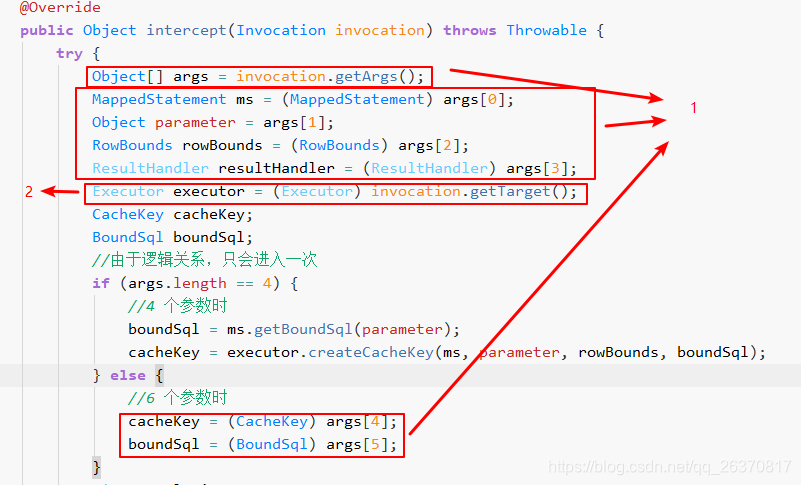MyBatis拦截器–从基础到与Spring Boot整合
前言
MyBatis拦截器是Java持久层框架,最近在研究拦截器的写法。本以为会很复杂,实际上从使用上来说,是很简单的.
本文主要介绍的时各个方法和注解的含义及使用方式,并且与Spring Boot进行简单的整合。
话不多说,开始说明。
关于拦截器
Mybatis拦截器的写法很简单,需要继承Interceptor类,重写其中的intercept()、plugin()、setProperties()。
package org.apache.ibatis.plugin;
//import ingnore
public interface Interceptor {
Object intercept(Invocation invocation) throws Throwable;
Object plugin(Object target);
void setProperties(Properties properties);
}
具体如下:
@Intercepts(@Signature(type = Executor.class, method = "query", args = {MappedStatement.class, Object.class, RowBounds.class, ResultHandler.class}))
@Component
public class UserAuthorityDataInterceptor implements Interceptor {
@Override
public Object intercept(Invocation invocation) throws Throwable {
return invocation.proceed();
}
@Override
public Object plugin(Object target) {
return Plugin.wrap(target,this);
}
@Override
public void setProperties(Properties properties) {
}
}
这是先说方法,再说注解
方法
-
setProperties()方法主要是用来从配置中获取属性。如果是使用xml式配置拦截器,可在Mybatis配置文件中添加如下节点,属性可以以如下方式传递
<plugins> <plugin interceptor="tk.mybatis.simple.plugin.XXXInterceptor"> <property name="propl" value="valuel" /> <property name="prop2" value="value2" /> </plugin> </plugins>如果在
Spring boot中使用,则需要单独写一个配置类,如下:@Configuration public class MybatisMapperAutoConfiguration{ @Bean public void zipkinInterceptor(SqlSessionFactory sqlSessionFactory) { ZipkinInterceptor zipkinInterceptor = new ZipkinInterceptor(); Properties properties = new Properties(); properties.setProperty("prop1","value1"); zipkinInterceptor.setProperties(properties); sqlSessionFactory.getConfiguration().addInterceptor(zipkinInterceptor); } }如果说不需要配置属性,则在
spring boot中,不需要去编写配置类,只需要像我一样在拦截器上加个@Component即可。 -
plugin()方法用于指定哪些方法可以被此拦截器拦截。如下:@Override public Object plugin(Object target) { if (target instanceof Executor) { return Plugin.wrap(target, this); } return target; }Plugin.wrap()是个包装方法,如果需要此拦截器,则将此此拦截器连同入参中的target一起包装后返回,如果不需要则直接返回target另附具体
Plugin.wrap()的源码:public static Object wrap(Object target, Interceptor interceptor) { Map<Class<?>, Set<Method>> signatureMap = getSignatureMap(interceptor); Class<?> type = target.getClass(); Class<?>[] interfaces = getAllInterfaces(type, signatureMap); if (interfaces.length > 0) { return Proxy.newProxyInstance( type.getClassLoader(), interfaces, new Plugin(target, interceptor, signatureMap)); } return target; } -
intercept()方法是用来对拦截的sql进行具体的操作。这里拿分页插件
PageHelper中的类PageInterceptor进行说明。坐标:
com.github.pagehelper.PageInterceptor#intercept(Invocation)
-
invocation.getArgs()是从入参invocation获取拦截器所拦截方法的参数,其参数顺序和被拦截的方法保持一致,这个参数的个数以及参数具体是什么我们下一步说到@Signature注解时会讲。 -
获取执行器,可以用
Executor直接执行被我们修改过的sql,示例如下
这里就是不继续执行原来的方法体中的内容,而是去执行我们修改后的sql并且返回。
-
关于返回值
除了以上这种直接去执行我们修改过sql的方式,如果我们想让方法继续执行下去也是可以的。
只需要返回:
return invocation.proceed();
-
注解
MyBatis拦截器用到了两个注解:@Intercepts和@Signature
-
@Intercepts@Documented @Retention(RetentionPolicy.RUNTIME) @Target(ElementType.TYPE) public @interface Intercepts { Signature[] value(); }可以看到,其中是一个
Signature类型的数组,意味着一个拦截器可以拦截多种方法。 -
@SignatureSignature意为签名,署名。实际上作用也与语义相同:表明需要拦截方法的方法签名。
@Documented @Retention(RetentionPolicy.RUNTIME) @Target({}) public @interface Signature { Class<?> type(); String method(); Class<?>[] args(); }有三个参数,
type:类型method:方法名称args:方法参数
这三个参数可以确定一个方法。默认情况下,
MyBatis允许使用插件(拦截器)来拦截的接口和包括以下几个。- Executor ( update 、 query 、 flushStatements 、 commit 、 rollback 、 get Transaction、 close、 isClosed)
- ParameterHandler ( getParameterObj ect、setParameters)
- ResultSetHandler ( handleResul tSets 、 handleCursorResultSets 、 handleOutputParameters)
- StatementHandler (prepare、 parameterize、 batch、 update、 query)
实际上,我们只需要记住这几个接口名称就可以,其余我们可以根据实际需要去看源码来确定具体所需要拦截的类。
- 以
Executor的query方法举例说明@Signature是如何确定一个方法。

如果我们需要拦截第一个方法,只需要这么写
@Signature@Signature(type = Executor.class, method = "query", args = { MappedStatement.class, Object.class, RowBounds.class, ResultHandler.class, CacheKey.class, BoundSql.class } )可以注意看,
type的值与类名相同,method与方法名相同,为了避免方法重载,args中指定了各个参数的类型和个数。-
如果我们想拦截多个方法,比如说上图1和2的方法我们都想拦截到,只需要再加个
@Signature就可以,要记得@Intercepts的value可是数组啊 -
@Intercepts( { @Signature(type = Executor.class, method = "query", args = {MappedStatement.class, Object.class, RowBounds.class, ResultHandler.class}), @Signature(type = Executor.class, method = "query", args = {MappedStatement.class, Object.class, RowBounds.class, ResultHandler.class, CacheKey.class, BoundSql.class}), } )
与Spring Boot整合
与Spring Boot整合这一块就简单许多,主要有两种方法,其实在上文中已有交代。
-
手写一个配置类
@Configuration public class MybatisMapperAutoConfiguration{ @Bean public void zipkinInterceptor(SqlSessionFactory sqlSessionFactory) { ZipkinInterceptor zipkinInterceptor = new ZipkinInterceptor(); Properties properties = new Properties(); properties.setProperty("prop1","value1"); zipkinInterceptor.setProperties(properties); sqlSessionFactory.getConfiguration().addInterceptor(zipkinInterceptor); } } -
在拦截器上加
@Component注解@Intercepts(@Signature(type = Executor.class, method = "query", args = {MappedStatement.class, Object.class, RowBounds.class, ResultHandler.class})) @Component public class UserAuthorityDataInterceptor implements Interceptor
资料参考
《MyBatis从入门到精通》——刘增辉(PageHelper作者)








 本文介绍了MyBatis拦截器的基础知识,包括如何配置和使用拦截器,以及如何与Spring Boot进行整合。文章详细讲解了拦截器的方法、注解以及在实际操作中的应用,如分页插件示例。最后提到了两种在Spring Boot中整合MyBatis拦截器的方法。
本文介绍了MyBatis拦截器的基础知识,包括如何配置和使用拦截器,以及如何与Spring Boot进行整合。文章详细讲解了拦截器的方法、注解以及在实际操作中的应用,如分页插件示例。最后提到了两种在Spring Boot中整合MyBatis拦截器的方法。
















 1454
1454

 被折叠的 条评论
为什么被折叠?
被折叠的 条评论
为什么被折叠?








